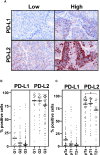PD-L2 Is Constitutively Expressed in Normal and Malignant Urothelium
- PMID: 33718196
- PMCID: PMC7951139
- DOI: 10.3389/fonc.2021.626748
PD-L2 Is Constitutively Expressed in Normal and Malignant Urothelium
Abstract
The use of immune checkpoint blockade, in particular PD-1 and PD-L1 inhibitors, is now commonplace in many clinical settings including the treatment of muscle-invasive bladder cancer (MIBC). Notwithstanding, little information exists regarding the expression of the alternative PD-1 ligand, PD-L2 in urothelial bladder cancer (UBC). We therefore set out to characterise the expression of PD-L2 in comparison to PD-L1. Firstly, we assessed PD-L2 expression by immunohistochemistry and found widespread expression of PD-L2 in UBC, albeit with reduced expression in MIBC. We further investigated these findings using RNA-seq data from a cohort of 575 patients demonstrating that PDCD1LG2 (PD-L2) is widely expressed in UBC and correlated with CD274 (PD-L1). However, in contrast to our immunohistochemistry findings, expression was significantly increased in advanced disease. We have also provided detailed evidence of constitutive PD-L2 expression in normal urothelium and propose a mechanism by which PD-L2 is cleaved from the cell surface in MIBC. These data provide a comprehensive assessment of PD-L2 in UBC, showing PD-L2 is abundant in UBC and, importantly, constitutively present in normal urothelium. These data have implications for future development of immune checkpoint blockade, and also the understanding of the function of the immune system in the normal urinary bladder.
Keywords: PD-L1 (B7-H1 CD274); PD-L2: programmed cell death ligand 2; bladder cancer; immune checkpoint inhibitors; normal urothelium.
Copyright © 2021 Dowell, Munford, Goel, Gordon, James, Cheng, Zeegers, Ward and Bryan.
Conflict of interest statement
RB has contributed to advisory boards for Olympus Medical Systems and Janssen, and undertakes research funded by UroGen Pharma, QED Therapeutics and Janssen. NJ has contributed to advisory boards for Merck USA and Pierre Fabre. The remaining authors declare that the research was conducted in the absence of any commercial or financial relationships that could be construed as a potential conflict of interest.
Figures



Similar articles
-
Correlation between messenger RNA expression and protein expression of immune checkpoint-associated molecules in bladder urothelial carcinoma: A retrospective study.Urol Oncol. 2017 May;35(5):257-263. doi: 10.1016/j.urolonc.2017.01.014. Epub 2017 Mar 11. Urol Oncol. 2017. PMID: 28291636
-
Immune checkpoint blockade as a potential therapeutic strategy for undifferentiated malignancies.Hum Pathol. 2018 Dec;82:39-45. doi: 10.1016/j.humpath.2018.06.034. Epub 2018 Jul 7. Hum Pathol. 2018. PMID: 30539796
-
Programmed Cell Death 1 Ligand 1 and Programmed Cell Death 1 Ligand 2 Are Expressed in Conjunctival Invasive Squamous Cell Carcinoma: Therapeutic Implications.Am J Ophthalmol. 2019 Apr;200:226-241. doi: 10.1016/j.ajo.2018.12.020. Epub 2019 Jan 8. Am J Ophthalmol. 2019. PMID: 30633894 Free PMC article.
-
The Controversial Role of PD-1 and Its Ligands in Gynecological Malignancies.Front Oncol. 2019 Oct 15;9:1073. doi: 10.3389/fonc.2019.01073. eCollection 2019. Front Oncol. 2019. PMID: 31681606 Free PMC article. Review.
-
Immunotherapy in Urothelial Cancer: Recent Results and Future Perspectives.Drugs. 2017 Jul;77(10):1077-1089. doi: 10.1007/s40265-017-0748-7. Drugs. 2017. PMID: 28493171 Review.
Cited by
-
Case Report: A Case of Sintilimab-Induced Cystitis/Ureteritis and Review of Sintilimab-Related Adverse Events.Front Oncol. 2021 Dec 23;11:757069. doi: 10.3389/fonc.2021.757069. eCollection 2021. Front Oncol. 2021. PMID: 35004277 Free PMC article.
-
The Vanishing Clinical Value of PD-L1 Status as a Predictive Biomarker in the First-Line Treatment of Urothelial Carcinoma of the Bladder.Cancers (Basel). 2024 Apr 17;16(8):1536. doi: 10.3390/cancers16081536. Cancers (Basel). 2024. PMID: 38672618 Free PMC article.
-
Prognostic Significance of PD-L2 Expression in Association with Neutrophil-to-Lymphocyte Ratio in Urothelial Carcinoma of the Bladder.Asian Pac J Cancer Prev. 2023 Aug 1;24(8):2673-2679. doi: 10.31557/APJCP.2023.24.8.2673. Asian Pac J Cancer Prev. 2023. PMID: 37642053 Free PMC article.
-
Cytokine release syndrome and cancer immunotherapies - historical challenges and promising futures.Front Immunol. 2023 May 25;14:1190379. doi: 10.3389/fimmu.2023.1190379. eCollection 2023. Front Immunol. 2023. PMID: 37304291 Free PMC article. Review.
-
PD-1 immunology in the kidneys: a growing relationship.Front Immunol. 2024 Oct 23;15:1458209. doi: 10.3389/fimmu.2024.1458209. eCollection 2024. Front Immunol. 2024. PMID: 39507530 Free PMC article. Review.
References
-
- Cancer Research UK . (2020) Bladder Cancer https://www.cancerresearchuk.org/health-professional/cancer-statistics/s... [Accessed May 15 2020]
LinkOut - more resources
Full Text Sources
Other Literature Sources
Research Materials

